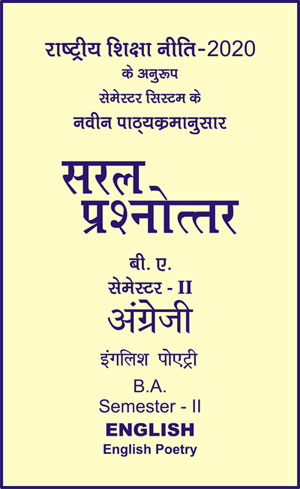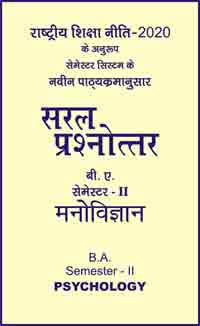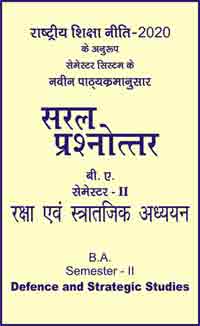|
बी ए - एम ए >> बीए सेमेस्टर-2 - अंग्रेजी - इंगलिश पोएट्री बीए सेमेस्टर-2 - अंग्रेजी - इंगलिश पोएट्रीसरल प्रश्नोत्तर समूह
|
5 पाठक हैं |
|||||||
बीए सेमेस्टर-2 - अंग्रेजी - इंगलिश पोएट्री
Objective Type Questions
For each of the following questions, four alternatives are given for the answer. Only one of them is correct. Choose the correct alternative.
1. When was John Keats born?
(a) 1789
(b) 1792
(c) 1795
(d) 1797
2. John Keats was the -
(a) Youngest of four children
(b) Youngest of three children
(c) Eldest of three children
(d) Eldest of four children
3. John Keats's father was -
(a) a shoemaker
(b) a clergy in a church
(c) an osteler
(d) a clerk
4. When Keats was trained as a medical student?
(a) in 1815
(b) in 1813
(c) in 1816
(d) in 1818
5. When Keats left school?
(a) age of Twenty
(b) age of Fiteen
(c) age of Seventeen
(d) age of Nineteen
6. When Keat entered a hospital in London?
(a) 1816
(b) 1817
(c) 1815
(d) 1819
7. What was profession of John Keats?
(a) an offical clerk
(b) a surgeon in hospital
(c) a businessman
(d) a record clerk
8. Keats's a small volume of poems was published in -
(a) 1817
(b) 1819
(c) 1821
(d) 1822
9. Keats's brother, Tom died in the year of-
(a) 1816
(b) 1818
(c) 1820
(d) 1822
10. "Keats senses were as we know infinitely more acute than most people's when to his normal abnormality in his respect was added the sting of sexual desire." who said about keats?
(a) Miss Hathway
(b) Miss Howell
(c) Shelley
(d) Thorpay
11. Keats was a -
(a) Realistic poet
(b) Transitional poét
(c) Noe-classical poet
(d) Romantic poet
12. Wordsworth and shelley believed in the vitality of Nature, Keats -
(a) Hates the nature
(b) Love the nature
(c) Explicit the nature
(d) Love and appreciate the nature
13. "Ode on a Gracian Urn" was a -
(a) Love poem
(b) Classical poem
(c) Realistic poem
(d) None of these
14. The ode shows the full force of -
(a) Homer influence
(b) Hebrew influence
(c) Hellenic influence
(d) Shakespeare influence
15. The central thought of "Ode on Gracian urn" was -
(a) Peace an War
(b) Truth and Beauty
(c) Love and Hate
(d) None of these
16. "Beauty is truth, truth beauty- that is all," refers to -
(a) Ode to Nightingale
(b) Ode to Wind
(c) Olde to Eve
(d) Ode on a Graican Urn
17. "Ode on Melancholy" is written by -
(a) Philip Sydney
(b) John Keats
(c) Byron
(d) Shelley
18. "Season of mists and mellow fruitfulness," refers to -
(a) Ode to Nightingale
(b) Ode to Melancholy
(c) Ode to Autumn
(d) Ode on Gracian Urn
19. "Thou shalt remain, in midst of other woe
Thou ours, a friend of man, to whom they say'st," To whom the poet addresses here -
(a) His friend
(b) Old pastoral
(c) His brother
(d) Cold pastoral
20. "A strategem that makes the beldame start," refers to -
(a) Ode to Autumn
(b) Ode on Grecian Urn
(c) Ode to Nightingale
(d) The Eve of St. Agnes
21. Keats is a poet of -
(a) Nature
(b) Beauty
(c) Urban life
(d) Rural life
22. Keats Odes are -
(a) Narrative
(b) Objective
(c) Descriptive
(d) Subjective
23. Keats is an artist first of all, it is beacuse of this quality that he is with -
(a) Pope
(b) Shakespeare
(c) Wordsworth
(d) Milton
24. Keats developed his love affair with -
(a) Edna
(b) Elizabeth
(c) Fanny Brawne
(d) Diana
25. Most of the Odes mirror his -
(a) Love
(b) Frustration
(c) Inner conflicts
(d) Cheerfulness
26. Keats was a -
(a) Sensuous poet
(b) Elegiac poet
(c) Satirical poet
(d) Didactic poet
27. Keats died at the age of -
(a) 24
(b) 26
(c) 28
(d) 22
28. Keats died in -
(a) France
(b) England
(c) Rome
(d) Italy
29. "La Belle Dame Sans Merci" was written in -
(a) 1822
(b) 1819
(c) 1820
(d) 1821
30. "La Belle Dame Sans Merci" is -
(a) an Ode
(b) an Elegy
(c) a Monologue
(d) a Ballad
31. 'Bacchus' (line 32) refers to -
(a) The god of war
(b) The god of love
(c) The god of wine
(d) The god of hope
32. The poem has staza form consisting
(a) Six lines
(b) Four lines
(c) Eight lines
(d) Ten lines
33. 'Requiem' (line 60) refers to -
(a) A song of delight
(b) a song of love
(c) a song of mourning
(d) a song of war
34. How does the song of the nightingale's react on Keats -
(a) Keats think about Ruth loneliness
(b) Keats think about his brother
(c) Keats think about beloved loneliness
(d) Keats think about his wife's depression
35. Keats wrote his earlier poetry at the age of -
(a) 19
(b) 20
(c) 22
(d) 25
36. Keats father was killed by -
(a) Theif
(b) Rogue
(c) Fall from a horse
(d) None of these
37. Keats 'Hypenion' was written in
(a) Two books
(b) Three books
(c) Six books
(d) Seven books
38. 'Lamia' or 'The Serpent Woman' was published in -
(a) 1817
(b) 1820
(c) 1819
(d) 1822
39. Keats 'Lamia' is on -
(a) Shakespeare's 'Isabella'
(b) Mathew Aronold's 'Melancholy'
(c) Burton's Anatomy of melancholi'
(d) Pope's "The rape of the Lock
40. "Beauty is truth, truth beauty - That is all," refers to -
(a) Keats 'La Belle Dame Sans Merci
(b) Ode on Grecian Urn
(c) Hyperion
(d) Ode to Nightingale
41. "A thing of beauty is a joy for ever," refers to -
(a) Endymion
(b) The Eve of St. Agnes
(c) Lamia
(d) Isabella
42. The title of 'La Belle Dame Sans Merci," has taken from -
(a) Italion poet
(b) Greek poet
(c) French poet
(d)None of these
43. All of the following are among keats great odes of 1819, except -
(a) Ode on melancholy
(c) Ode on Grecian Urn
(b) Ode to a Nightingale
(d) Ode to the West, Wind
44. The overall tone of this poem can best be described as -
(a) Mournful
(b) Emotional
(c) Sarcastic
(d) Vulgur
45. John Keats wrote many of what kind of poem?
(a) Epics
(b) Odes
(c) Sonnets
(d) Elegies
46. "A thing of beauty is a joy for ever" is the opening line of which poem?
(a) La Belle Dame Sans Merci
(b) Ode on Grecian Urn
(c) Endymion
(d) Ode on Indolence
47. To which movement did Keats belong -
(a) Marrism
(b) Impressionism
(c) Romanticism
(d) Judaism
48. Which of these did Keats write an -
(a) Nightingale
(b) Robin
(c) Skylark
(d) Magple
49. Which fellow poet wrote "Adonais" as elegy to keats?
(a) Lord Byron
(b) Wordsworth
(c) Coleridge
(d) Shelley
50. W.B. Yeats is from :
(a) Scotland
(b) Germany
(c) England
(d) Ireland
51. Full name of W.B. Yeats is :
(a) Waugh Butler Yeats
(b) William Butler Yeats
(c) William Bruce Yeats
(c) None of these
52. W.B. Yeats intends to go:
(a) Innisfree
(b) England
(c) Valambrossa
(d) Scotland
53. W.B. Yeats was awarded Nobel Prize for literature in :
(a) 1921
(b) 1922
(c) 1923
(d) 1924
54. The phrase "A midnight are a glimmer and noon a public glow":
(a) The Lake Isle of Innisfree
(b) Nightingale
(c) Tyger
(d) The World is Too Much With Us
55. Who remarked, "Beauty is truth, truth beauty"?
(a) Shelley
(b) Keats
(c) Tagore
(d) Eliot
56. In which stanza of "Ode on a Grecian Urn" does keats descirbe a scene of pastoral sacrifice?
(a) Second
(b) Third
(c) Fourth
(d) Fifth
57. Hellenism is the quality of whose poetry?
(a) Keats
(b) Coleridge
(c) Browning
(d) Southey
58. "Hellenism" means :
(a) Love for nature
(b) Love for beauty
(c) Love for liberty
(d) Love for art-culture of the anicent Greece
59. In classical mythology, Neptune is known as:
(a) Tree God
(b) God of winds
(c) God of rains
(d) Sea God
60. "She cannot fade, though thou hast not thy bliss, For ever wilt thou love and she be fair !"
(a) My Last Duchess
(b) Ode on a Grecian Urn
(c) Dover Beach
(d) Let me not to the Marriage of True Minds
61. "Ode to the Nightingale" was written by:
(a) Shelley
(b) Keats
(c) Wordsworth
(d) Matthew Arnold
62. Sophocles was:
(a) A Greek dramatist
(b) A Latin poet
(c) An Elizabethan playwright
(d) A Victorian novelist
63. Which epithet keats does not use for the Grecian Urn?
(a) Cold pastoral
(b) Bride of quietness
(c) Darkling
(d) Sylvan historian
64. The first picture that the speaker sees on the urn in the poem "Ode on a Grecian Urn" is of:
(a) Attic
(b) Cherry Orchard
(c) Ancient Greek Farmlands
(d) Men Chasing Women
65. Why does the speaker address the urn as 'Cold Pastoral' in "Ode on a Grecian Urn"?
(a) Because of cold winter
(b) Because it illustrates an image of life in ancient Greek farmlands
(c) Because of indifference
(d) Because villagers are close to nature
66. In "Ode on a Grecian Urn", Keats says that "unheard melodies" are
sweeter than those that are heard. He means:
(a) Imagination is superior to the senses
(b) Imagination and senses are intertwined
(c) Old melodies are golden
(d) Old vs. New
67. The overall tone of the poem "Ode on a Grecian Urn" is:
(a) Good vs. Evil
(b) Love and Marriage
(c) War and Peace.
(d) Admiring and Melancholy
68. "Beauty is truth, truth beauty, ...... that is all Ye know on earth, and all ye need to know." These are the concluding lines of which poem?
(a) Presence in absence
(b) The World Is Too Much With Us
(c) Ode on a Grecian Urn
(d) The Love Song of J. Alfred Prufrock
|
|||||
- Chapter - 1 Forms of Poetry & Stanza Forms
- Objective Type Questions
- Answers
- Chapter - 2 Poetic Device
- Objective Type Questions
- Answers
- Chapter - 3 "Let Me Not to the Marriage of True Minds" (Sonnet No. 116)
- Objective Type Questions
- Answers
- Chapter - 4 "On His Blindness"
- Objective Type Questions
- Answers
- Chapter - 5 "Present in Absence"
- Objective Type Questions
- Answers
- Chapter - 6 "Essay on Man”
- Objective Type Questions
- Answers
- Chapter - 7 "Elegy Written in a Country Churchyard”
- Objective Type Questions
- Answers
- Chapter - 8 "The World is Too Much with Us"
- Objective Type Questions
- Answers
- Chapter - 9 "Ode on a Grecian Urn"
- Objective Type Questions
- Answers
- Chapter - 10 "Break, Break, Break"
- Objective Type Questions
- Answers
- Chapter - 11 "How Do I Love Thee?"
- Objective Type Questions
- Answers
- Chapter - 12 "Dover Beach"
- Objective Type Questions
- Answers
- Chapter - 13 "My Last Duchess'
- Objective Type Questions
- Answers
- Chapter - 14 "The Love Song of J. Alfred Prufrock"
- Objective Type Questions
- Answers
- Chapter - 15 "The Lake Isle of Innisfree"
- Objective Type Questions
- Answers
- Chapter - 16 "Church Going"
- Objective Type Questions
- Answers
- Chapter - 17 Rhetoric and Prosody - Practical Criticism
- Objective Type Questions
- Answers














